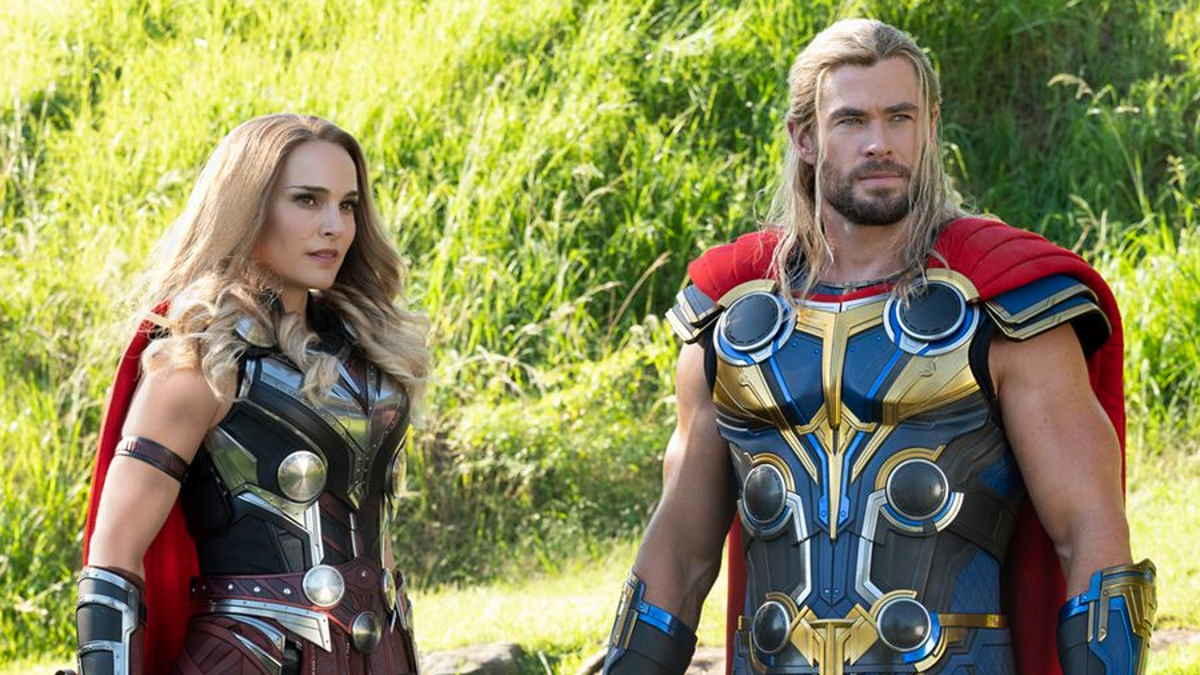
There’s no doubt that Taika Waititi’s entrance into the MCU was the jolt that Thor’s story needed. The writer-director not only re-invigorated the Chris Hemsworth-led franchise but also brought new vigor to the studio with his unique style full of wacky humor and a flash of color. Thor: Love and Thunder contains that same vigor Waititi brought to Thor: Ragnarok, creating a film that’s a visually stunning blast with ‘80s rock flavor. However, the biggest flaw of Love and Thunder may be Waititi’s overuse of his schtick in trying to recreate the success of his last Thor entry.
The film is quick to introduce its villain. Gorr (a hardly recognizable Christian Bale) is mourning the loss of his daughter when he meets his god, Dionysus. He seeks his help and wonders why he could let his daughter die. Gorr quickly loses his faith when it becomes clear that Dionysus doesn’t care about those who worship him. At that moment, Gorr is chosen to wield the Necrosword. After his encounter with Dionysus, he begins to view gods as cruel and useless. As the subsequently named God Butcher, he vows to kill them all as revenge for his daughter’s death – the Necrosword giving him the power he needs to do so.

In the meantime, Thor is busy fighting alongside the Guardians of the Galaxy. The post-Endgame God of Thunder is, to the Guardians’ annoyance, the cool, calm, and often careless himbo we remember. However, he’s still trying to find himself, and under that muscular exterior is a man struggling to deal with the pain of everyone he’s lost. Gorr the God Butcher keeps him distracted though, as Gods begin to send distress calls that they are in danger, and Asguard is Gorr’s next target. When Thor arrives at his now-earthbound home, it’s blanketed in shadow monsters, and surprisingly, lighting. Thor not only comes face to face with his next fearsome foe but also someone who looks like him and wields his power. Turns out, it’s Jane Foster (Natalie Portman), back for the first time since Thor: The Dark World. Seeing his ex-girlfriend now hanging out with his ex-hammer, Mjölnir, is a shock to Thor and an exciting transformation of the character for the audience. Love and Thunder becomes about defeating the bad guy side-by-side, but also bringing closure to their relationship in the process.
Just like Waititi’s first foray with the MCU, Love and Thunder is a blast. It’s visually stunning, with new worlds to explore. Curiously, while Waititi was praised for painting Thor’s universe in vibrant color in Ragnarok, the best-looking sequence in this film is the one drained of color in the black and white Shadow Realm. Again, Waititi brings his touch of uniqueness. The action sequences, accompanied by Guns N’ Roses hits, are impressive in their choreography and fixating in their exhilaration. But while Waititi’s comedy was revered in Ragnorok, it’s pretty hit or miss here. The film is in tonal opposition. The first half is focused on screaming goats and contains amateur Asgardian theatre recreations of past events, featuring some surprising cameos, but the latter halves carry much more emotional weight. It’s hinted it may go this route when it becomes clear that Thor is going through a lot of pain, explaining his attachment issues to Star-Lord (Chris Pratt) and how he would rather avoid love than experience loss. This moment of reflection is followed by jokes that fall flat. The film is at its best when Waititi forgets the humor and lets Thor meditate on his feelings, leading to some beautiful, heartfelt moments between Jane and Thor later in the film.

Hemsworth is as fun to watch as ever, taking down enemies as Thor with ease and style – and his charm makes any bad joke bearable. It’s also fantastic to see him alongside Portman again, and their chemistry here is stronger than it’s ever been – their moving scenes together in the film’s climax really tugging on heartstrings. However, Jane’s transformation into The Mighty Thor feels incredibly rushed, but she makes her mark all the same; when she picks up the hammer, its pieces splitting, and launching them at all enemies at once is the best part of the fight scenes. Bale gets more to work with as Gorr, while also feeling a bit rushed. He’s definitely a highlight and acts circles around everyone. Bale is truly terrifying and brings a surprising horror element as he hides in the shadows with monsters doing his bidding. However, while he is a butcher of gods, we never see him do any butchering. It would have been beneficial to see what the universe would have been like without gods. Fighting alongside Thor and Jane are Korg (Waititi) and Valkyrie (Tessa Thompson). Korg doesn’t seem to have a purpose other than to bring comic relief, and Valkyrie is simply the King of running the tourist hot spot Asgard and that’s it. While Thompson spends a lot of time in the middle of the action, nothing is added to her character or story – a big disappointment for one of the few queer MCU characters.
Waititi’s schtick may be getting tiresome, but with Love and Thunder, he proves he doesn’t need to stick to it. Breaking away from the laughs, the film’s title becomes an apt one. The themes of love, loss, and questions of faith are poignant. Heroes and gods disappoint and we can’t rely on them. What’s stronger is love – something both Thor and Gorr learn. As Star-Lord explains to Thor, it’s better to feel the pain that may result from love than never loving at all. Love shapes us, forges our path, and by breaking down his walls, Thor’s arc comes full circle as he makes peace with his past and lets his heart open up to love again with the electricity of two lighting bolts coming together.



